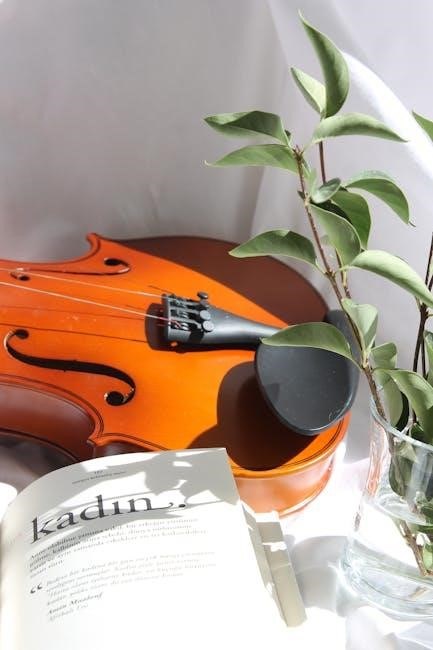suzuki book 3 violin pdf
Suzuki Violin Book 3 is a cornerstone in the Suzuki Method, offering advanced pieces like Gavotte by P. Martini and Minuet by J.S. Bach, fostering technical and musical growth.
1.1 Overview of the Suzuki Method
The Suzuki Method, developed by Shinichi Suzuki, is a renowned approach to music education emphasizing the potential of every child to learn through a nurturing environment. It is rooted in the belief that music education should foster the development of the whole child, including character and discipline. The method encourages early starting ages, parental involvement, and the use of repertoire tailored to the child’s developmental stages. A key principle is the “mother-tongue” approach, where learning music mimics language acquisition through immersion and repetition. The method also stresses the importance of high-quality recordings to aid practice and mastery. By focusing on technique, tone, and expression, the Suzuki Method aims to create not only skilled musicians but also compassionate individuals; Its holistic philosophy has made it a cornerstone of music education worldwide, offering a structured yet supportive path for students to grow musically and personally.
1.2 Importance of Book 3 in the Suzuki Curriculum
Suzuki Violin Book 3 holds a pivotal role in the Suzuki curriculum, marking a significant transition from foundational skills to more advanced techniques. It introduces pieces such as Gavotte by P. Martini and Minuet by J.S. Bach, which refine intonation, tone production, and bow control. Book 3 is where students begin to explore vibrato, a crucial expressive element, and develop greater musicality. The repertoire shifts from simpler folk tunes to more complex classical works, enhancing the student’s understanding of phrasing and articulation. This book also emphasizes proper posture and bowing techniques, preparing students for the technical demands of higher-level pieces. By mastering Book 3, students build confidence and readiness for the challenges of subsequent volumes, making it a cornerstone of the Suzuki Method’s progressive learning structure. It bridges the gap between basic proficiency and artistic expression, fostering a deeper connection to music and performance.
1.3 Historical Background of Suzuki Violin Book 3
Suzuki Violin Book 3 was first published in 1978 as part of the Suzuki Method, a revolutionary approach to music education developed by Dr; Shinichi Suzuki. The book was carefully curated to include works by renowned composers such as P. Martini and J;S. Bach, reflecting Suzuki’s belief in the importance of exposing students to high-quality, classical repertoire. Over the years, the book has undergone revisions, with the most notable being the 2008 revised edition, which refined the selection of pieces and improved the overall structure. The inclusion of Gavotte in G and Minuet exemplifies Suzuki’s emphasis on fostering both technical proficiency and musical expression. This volume has become a cornerstone in the Suzuki curriculum, widely used by teachers and students worldwide. Its historical significance lies in its role as a bridge between foundational skills and advanced techniques, solidifying the Suzuki Method’s legacy in music education.

Contents of Suzuki Violin Book 3
Suzuki Violin Book 3 contains a carefully selected repertoire of classical pieces, etudes, and exercises, structured to advance technical and musical skills progressively, with a focus on refinement and artistry.
2.1 List of Pieces in Book 3
Suzuki Violin Book 3 features a diverse and challenging repertoire, including Gavotte by P. Martini, Minuet by J.S. Bach, and Gavotte in G. It also includes Bourrée by J.S. Bach, Concerto for Lute (transcribed for violin) by Vivaldi, and Minuet No. 2 by J.S. Bach. These pieces are carefully selected to enhance technical skill and musical expression. The book introduces more complex rhythms and bowing techniques, preparing students for advanced repertoire. Vibrato is also introduced in this volume, starting with simple exercises and gradually incorporating it into pieces like the Vivaldi Concerto. The inclusion of these works ensures a balanced development of both left-hand and bowing techniques, while fostering a deeper understanding of musical phrasing and style. This structured progression makes Book 3 an essential step in the Suzuki Method curriculum.
2.2 Composers and Arrangers Featured in Book 3
Suzuki Violin Book 3 showcases works by renowned composers such as P. Martini, J.S. Bach, and Vivaldi, whose pieces form the core of the repertoire. Martini’s Gavotte and Bach’s Minuet and Bourrée are central to the volume, offering a blend of Baroque elegance and technical challenge. Vivaldi’s Concerto for Lute, transcribed for violin, adds a virtuosic dimension to the book. The arrangements are carefully adapted by Dr. Shinichi Suzuki, ensuring they are pedagogically suitable while maintaining their musical integrity. These composers and arrangers contribute to the method’s emphasis on mastering classical technique and interpreting diverse musical styles. Their works provide a rich foundation for students to advance their skills and appreciation of classical music. The selection reflects Suzuki’s commitment to creating a balanced and inspiring curriculum for young violinists.
2.3 Piano Accompaniment in Book 3
The piano accompaniment in Suzuki Violin Book 3 plays a crucial role in enhancing the musicality and technical development of students. Each piece is accompanied by a carefully crafted piano score, designed to support the violinist while adding harmonic richness and depth. The accompaniments are integral to the learning process, helping students develop timing, phrasing, and intonation. They are available in separate books, ensuring that teachers and accompanists can effectively support students during practice and performance. The interplay between violin and piano fosters a stronger musical connection and prepares students for more complex collaborative playing. The accompaniment scores are widely available in both physical and digital formats, including PDF downloads, making them accessible to a global audience of Suzuki method practitioners. This integration of piano accompaniment underscores the method’s emphasis on ensemble playing and musical expression from an early stage.

Technical Requirements for Book 3
Suzuki Violin Book 3 introduces advanced techniques such as vibrato, complex bowing patterns, and precise intonation. Students must refine finger dexterity, shifting positions, and dynamic control to master its repertoire effectively.
3.1 Bowing Techniques Introduced in Book 3
Suzuki Violin Book 3 introduces advanced bowing techniques such as spiccato, martelé, and detaché, enhancing articulation and tone. These techniques are applied in pieces like Gavotte and Minuet, requiring precise bow placement and control. The spiccato stroke, for instance, demands a light, springy bow action, while martelé involves short, forceful accents. Students also refine their ability to switch between legato and staccato playing, improving their overall technical facility. These bowing techniques not only expand the student’s expressive range but also prepare them for the more complex repertoire in later books. Proper bow grip and arm weight distribution are emphasized to achieve the desired tonal quality and articulation.
3.2 Intonation and Tuning Challenges
In Suzuki Violin Book 3, students encounter more complex pieces, such as Gavotte and Minuet, which present intonation and tuning challenges. The shift to higher positions on the fingerboard requires precise finger placement and a well-developed ear. Pieces like Gavotte in G demand accurate intonation in higher registers, where the violin’s tuning can be less forgiving. Additionally, double stops and chords introduce the need for tuning between strings, further complicating pitch accuracy. Teachers often emphasize scales and arpeggios to improve intonation skills. Students must also develop a keen awareness of pitch to navigate these challenges effectively. While mastering intonation in Book 3 can be daunting, it lays a critical foundation for advanced repertoire. Regular practice with a tuner or drone can aid in refining pitch accuracy, ensuring a strong technical and musical progression.

The introduction of vibrato in Suzuki Violin Book 3 marks a significant milestone in a student’s technical and musical development. Vibrato is typically introduced when students begin studying pieces like the Vivaldi A minor Concerto, as it enhances expressiveness and tonal richness. Teachers often start with slow, wide vibrato to help students control the movement. Proper finger placement and relaxed wrist and arm technique are emphasized to produce a natural, even vibrato. Consistent practice with exercises and etudes is essential for mastering this skill. Recordings and demonstrations are valuable tools to guide students in developing a beautiful, expressive vibrato. This technique not only elevates the musicality of the pieces in Book 3 but also prepares students for more advanced repertoire. Vibrato practice should be integrated into daily routines, focusing on consistency and control.

Teaching Strategies for Suzuki Book 3
Teaching Suzuki Book 3 involves introducing vibrato with the Vivaldi A minor Concerto, emphasizing proper posture, and incorporating practice techniques for complex pieces to enhance technical and musical growth.
4.1 When to Introduce Vibrato
Introducing vibrato in Suzuki Violin Book 3 is a significant milestone, typically beginning when students start the Vivaldi A minor Concerto. This piece provides the ideal context for developing vibrato, as it requires expressive nuances. Teachers should guide students to produce a natural, controlled vibrato by starting with slow, small movements of the left-hand fingers. It’s essential to emphasize proper intonation and ensure the vibrato enhances the music without sacrificing pitch accuracy. Practicing vibrato in conjunction with the concertos and other pieces in Book 3 helps integrate this technique seamlessly into the student’s playing. By introducing vibrato at this stage, students can refine their musicality and expression, preparing them for more advanced repertoire.

4.2 Music Reading Skills in Book 3
Music reading skills are a critical focus in Suzuki Violin Book 3, as students transition from relying on memory to interpreting written music. While formal music reading often begins in Book 4, Book 3 lays the groundwork by introducing more complex rhythms, dynamics, and articulations. Pieces like the Gavotte in G and Minuet require students to recognize and execute syncopation, staccato, and legato markings accurately. Teachers encourage students to follow the score while listening to recordings, fostering a deeper connection to the music. This stage emphasizes understanding musical notation, key signatures, and phrasing. By the end of Book 3, students should demonstrate improved sight-reading abilities and a stronger connection to the musical score, preparing them for the more advanced repertoire in subsequent books.
4.3 Practice Techniques for Complex Pieces
Mastering the complex pieces in Suzuki Violin Book 3 requires deliberate and structured practice techniques. Students should begin by breaking challenging sections into smaller, manageable parts, focusing on precise intonation, rhythm, and bow control. Slow practice is essential for building technical accuracy, while gradually increasing tempo helps develop musicality. Using a metronome can enhance rhythm accuracy and consistency. Additionally, incorporating accompaniment tracks or piano parts during practice fosters a sense of ensemble playing and phrasing. Teachers often recommend practicing with a drone or tuner to refine intonation. Regular review of earlier pieces ensures retention and reinforces foundational skills. Encouraging daily practice, even for short periods, promotes steady progress. By combining focused technique work with expressive playing, students can navigate the complexities of Book 3 with confidence and artistry.

Performance Tips for Suzuki Book 3
Focus on proper posture and bow grip to maintain clarity. Emphasize precise intonation and dynamic control. Encourage expressive phrasing and emotional connection to enhance musicality in performance.
5.1 Developing Proper Posture and Stance
Proper posture is essential for optimal sound production and comfort. Ensure the violin is held at a slight angle, with the chin rest securely fitted. Feet should be shoulder-width apart, weight evenly distributed. The bow grip should be relaxed, with fingers curved gently. Regular practice in front of a mirror can help students monitor their stance. Teachers often recommend adjusting the chin rest and shoulder rest to accommodate individual comfort. Proper alignment prevents fatigue and injury, allowing for precise technique execution. A well-balanced posture fosters confidence and enhances performance quality, making it a priority in Suzuki Book 3 studies.
5.2 Improving Intonation in Performance
Accurate intonation is crucial for a polished performance in Suzuki Violin Book 3. Students should practice playing in tune by listening to recordings and using a tuner. Regular scales and arpeggio exercises help develop pitch accuracy. Teachers often emphasize playing with good bow placement and consistent tone production. Isolating challenging passages and practicing them slowly can improve intonation. Encourage students to sing or hum the pitches before playing to internalize the correct notes. Additionally, incorporating drone accompaniments during practice can enhance pitch awareness. Correcting intonation errors early prevents bad habits and ensures a strong musical foundation. Regular feedback and constructive guidance from instructors are essential for refining pitch accuracy in performance.
5.3 Enhancing Musicality and Expression
Enhancing musicality and expression in Suzuki Violin Book 3 involves mastering dynamics, phrasing, and articulation. Students should focus on playing with feeling, understanding the emotional depth of each piece. Practicing with a strong emphasis on bow control and varied tonal colors can elevate performances. Vibrato, introduced in Book 3, adds warmth and expression to melodies. Encourage students to listen to professional recordings to internalize musical phrasing and nuances. Slow, deliberate practice of challenging passages helps refine expression. Teachers should guide students in exploring contrasting styles, from the elegance of Bach’s Minuet to the vitality of Vivaldi’s Concerto. Regular performance opportunities, even informal ones, build confidence and stage presence. By fostering a deep connection to the music, students develop a compelling and expressive sound that captivates audiences.

How to Download Suzuki Violin Book 3 PDF
To download Suzuki Violin Book 3 PDF, visit reliable sources like Amazon or Scribd. Ensure legality by purchasing from authorized platforms. Popular options include Suzuki Method International or iTunes.
6.1 Reliable Sources for Download
Reliable sources for downloading Suzuki Violin Book 3 PDF include official Suzuki Method websites, trusted music retailers like Amazon, and educational platforms such as Scribd. These platforms ensure authenticity and quality.
Additionally, authorized distributors like Alfred Music or Hal Leonard provide legal and accurate versions. Always verify the publisher and avoid unauthorized sites to prevent copyright infringement and ensure the best learning experience.
6.2 Legal Considerations for PDF Downloads
Downloading Suzuki Violin Book 3 PDF requires adherence to copyright laws. Ensure that you obtain the file from authorized sources like official Suzuki Method publishers or licensed retailers such as Amazon or Hal Leonard.
Unauthorized downloads from illegal websites can lead to legal consequences and deprive composers and publishers of their rightful compensation. Always verify the source’s legitimacy to avoid copyright infringement.
Additionally, many online platforms like Scribd or Google Drive host user-uploaded content, but these may not always be legally distributed. Prioritize purchasing from reputable music stores to support the creators and maintain compliance with intellectual property laws.
By choosing legal download options, you contribute to the sustainability of educational music resources while accessing high-quality, accurate materials essential for your violin studies.
6.3 Popular Platforms for Suzuki Book 3 PDF

Several platforms offer Suzuki Violin Book 3 PDF for download, providing convenient access to this essential resource. Amazon and iTunes are reliable sources, offering both digital and physical copies. Scribd and Google Drive are popular for user-shared content, though verify authenticity. Additionally, platforms like Hal Leonard and Musicnotes provide legal downloads, ensuring quality and accuracy. These platforms cater to different preferences, whether you prefer eBooks or printable formats. Always choose reputable sites to ensure you receive the correct and complete version of Suzuki Violin Book 3, supporting your musical journey effectively.

Resources and Accompaniments for Book 3
Resources and accompaniments for Suzuki Violin Book 3 include piano accompaniment books, official recordings, and online forums. These tools enhance practice and performance, providing essential support for mastering the repertoire.
7.1 Piano Accompaniment Books for Book 3
Piano accompaniment books for Suzuki Violin Book 3 are essential for providing harmonic support and rhythmic guidance during practice and performance. These books include arrangements of all pieces in Book 3, such as Gavotte by P. Martini and Minuet by J.S. Bach. They are specifically designed to complement the violin parts, ensuring a cohesive musical experience. Many accompaniment books are available in PDF format, offering convenience for teachers and students. Additionally, platforms like Amazon and iTunes provide digital versions, making them easily accessible. The accompaniments are often performed by renowned musicians, further enhancing the learning process. Using these resources helps students develop their musicality and expression effectively.
7.2 Recordings and Audio Resources
Recordings and audio resources are integral to the Suzuki Method, providing students with high-quality performances to model their playing. For Book 3, recordings feature renowned violinists like William Preucil, accompanied by pianists such as Cary Lewis. These recordings include all pieces from the book, offering clear interpretations of works by composers like P. Martini and J.S. Bach. They are available on platforms like Amazon and iTunes, ensuring easy access for practice and study.
These audio resources help students develop proper tone, phrasing, and rhythm. They also serve as inspiration, allowing learners to connect emotionally with the music. While recordings are invaluable, they should complement, not replace, personalized instruction. By listening regularly, students can refine their skills and deepen their understanding of the repertoire in Book 3.
7.3 Online Communities and Forums for Support
Online communities and forums provide invaluable support for students and teachers working through Suzuki Violin Book 3. Platforms like Scribd and specialized music forums offer spaces to share resources, ask questions, and connect with fellow musicians. These communities often include discussions on interpreting pieces, troubleshooting technical challenges, and sharing practice tips. Many forums also host experienced teachers who offer advice on mastering specific works from Book 3, such as the Gavotte by P. Martini or the Minuet by J.S. Bach.
Additionally, these forums can be a great way to access supplementary materials, such as PDFs of piano accompaniments or recordings. They foster a collaborative environment where learners can inspire and motivate one another. Engaging with these communities can enhance the learning experience and provide encouragement as students progress through Book 3.


